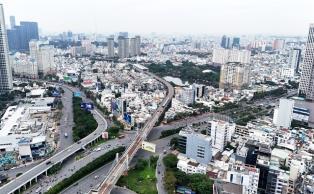To maintain a stable supply of livestock and poultry for the last months of 2025, the livestock sector and localities need to tighten quarantines and provide guidance on safe herd restoration, said Deputy Minister of Agriculture and Environment Phùng Đức Tiến.

HCM CITY — To maintain a stable supply of livestock and poultry for the last months of 2025, the livestock sector and localities need to tighten quarantines and provide guidance on safe herd restoration, said Deputy Minister of Agriculture and Environment Phùng Đức Tiến.
Recent storms No.10 and No.11 alone caused heavy damage to the central and northern provinces, killing or sweeping away tens of thousands of livestock and poultry, and severely damaging many farms and livestock facilities, Tiến said.
In that context, ensuring stable supply during Tết (Lunar New Year) while controlling diseases and restoring production has become a tough challenge for the entire industry, he said at a conference on Wednesday.
Amid complicated developments of natural disasters and epidemics, localities need to proactively develop plans for herd restoration, focus on ensuring biosafety in livestock farming, and shift from small-scale farming to large-scale centralised farming, he said.
"Each locality must review all stages from raw material areas, traceability, and disease control and prevention to meet rising demand during the Tết holiday," he said.
Over the past years, the livestock sector has maintained a stable growth rate of 4.5-5.9 per cent, he said.
For 2025, the sector is targeting growth of between 5.7 and 5.9 per cent.
This year’s total output is expected to reach 8.5 million tonnes of meat, 21 billion eggs, and 1.3 million tonnes of fresh milk, he said.
In the first nine months of this year, exports of livestock products reached US$447 million, up 18.6 per cent year-on-year.
The sector has also attracted many large enterprises to participate in investment, he said.
Đinh Viết Tú from the Department of Quality, Processing and Market Development said that the sector depends heavily on imported animal feed, with the cost of animal feed accounting for 65-70 per cent of the production cost.
This makes Việt Nam’s production costs 15-20 per cent higher than those of countries such as Thailand and Brazil.
The risk of recurrence of African swine fever and avian influenza, and competition from cheaper imported meat also challenge the industry, Tú said.
Regarding the livestock market in the last months of this year, the risk of disease and the impact of natural disasters can disrupt the supply chain, affecting domestic meat production.
However, the demand for livestock and poultry is forecast to increase sharply from now until the end of the year and reach its peak during the 2026 Lunar New Year when demand for food processing and consumption increases by 15-20 per cent, he said.
The key solution to stabilise prices and improve the industry’s competitiveness at the end of the year is to control diseases, ensure stable supply and promote production and consumption links, he said.
To reduce input costs, one of the decisive factors is to proactively source domestic inputs by expanding raw material sources, he added.
Dương Tất Thắng, director of Department of Animal Health and Production, said that entering the fourth quarter of 2025, the livestock industry faces many challenges, especially the African swine fever epidemic affecting pork supply in the northern and north central regions.
The industry has proactively coordinated with localities to assess the situation and prepare response solutions, Thắng said.
Disease prevention and control and biosafety herd restoration has been strengthened in Đồng Nai Province and the Cửu Long (Mekong) Delta to protect raw material areas and maintain the production chain, he said.
Meanwhile, the industry has stepped up trade promotion, expanding exports of poultry meat, milk and processed pork to Singapore and Hong Kong, he said.
Thắng emphasised that it is necessary to proactively produce and flexibly import to ensure food security and move towards sustainable livestock development. — VNS
- Tags
- Livestock sector
- supply
- Tết





